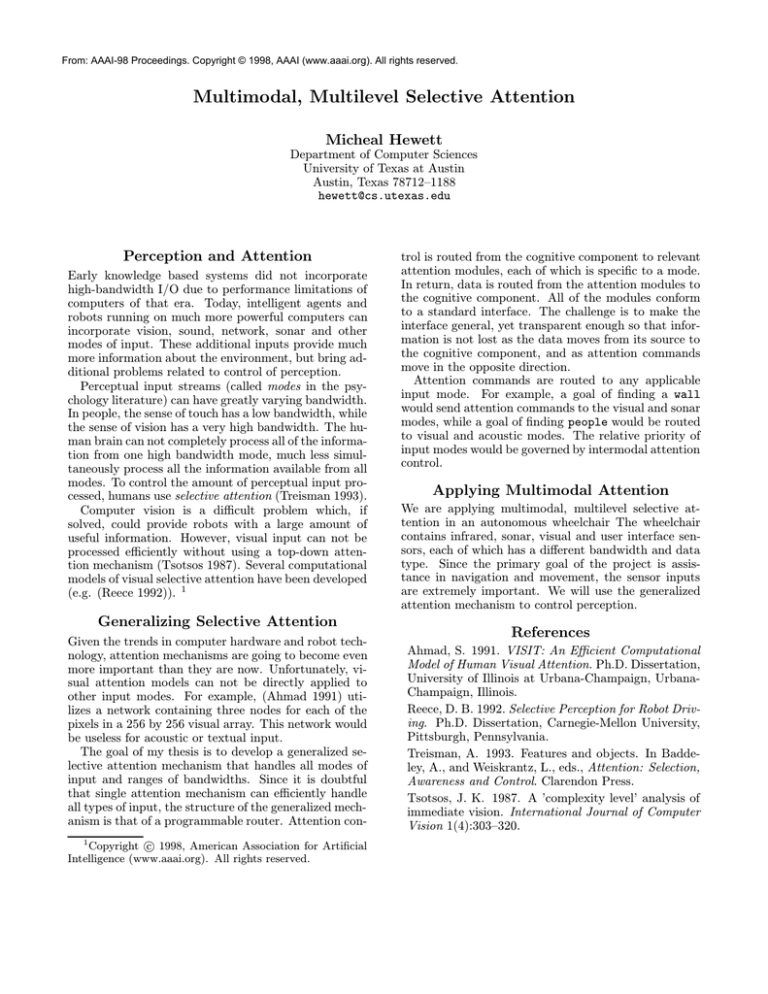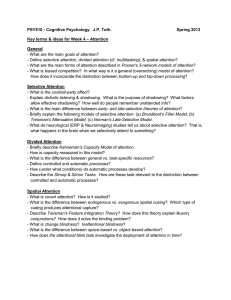
From: AAAI-98 Proceedings. Copyright © 1998, AAAI (www.aaai.org). All rights reserved.
Multimodal, Multilevel Selective Attention
Micheal Hewett
Department of Computer Sciences
University of Texas at Austin
Austin, Texas 78712–1188
hewett@cs.utexas.edu
Perception and Attention
Early knowledge based systems did not incorporate
high-bandwidth I/O due to performance limitations of
computers of that era. Today, intelligent agents and
robots running on much more powerful computers can
incorporate vision, sound, network, sonar and other
modes of input. These additional inputs provide much
more information about the environment, but bring additional problems related to control of perception.
Perceptual input streams (called modes in the psychology literature) can have greatly varying bandwidth.
In people, the sense of touch has a low bandwidth, while
the sense of vision has a very high bandwidth. The human brain can not completely process all of the information from one high bandwidth mode, much less simultaneously process all the information available from all
modes. To control the amount of perceptual input processed, humans use selective attention (Treisman 1993).
Computer vision is a difficult problem which, if
solved, could provide robots with a large amount of
useful information. However, visual input can not be
processed efficiently without using a top-down attention mechanism (Tsotsos 1987). Several computational
models of visual selective attention have been developed
(e.g. (Reece 1992)). 1
Generalizing Selective Attention
Given the trends in computer hardware and robot technology, attention mechanisms are going to become even
more important than they are now. Unfortunately, visual attention models can not be directly applied to
other input modes. For example, (Ahmad 1991) utilizes a network containing three nodes for each of the
pixels in a 256 by 256 visual array. This network would
be useless for acoustic or textual input.
The goal of my thesis is to develop a generalized selective attention mechanism that handles all modes of
input and ranges of bandwidths. Since it is doubtful
that single attention mechanism can efficiently handle
all types of input, the structure of the generalized mechanism is that of a programmable router. Attention con1
c 1998, American Association for Artificial
Copyright Intelligence (www.aaai.org). All rights reserved.
trol is routed from the cognitive component to relevant
attention modules, each of which is specific to a mode.
In return, data is routed from the attention modules to
the cognitive component. All of the modules conform
to a standard interface. The challenge is to make the
interface general, yet transparent enough so that information is not lost as the data moves from its source to
the cognitive component, and as attention commands
move in the opposite direction.
Attention commands are routed to any applicable
input mode. For example, a goal of finding a wall
would send attention commands to the visual and sonar
modes, while a goal of finding people would be routed
to visual and acoustic modes. The relative priority of
input modes would be governed by intermodal attention
control.
Applying Multimodal Attention
We are applying multimodal, multilevel selective attention in an autonomous wheelchair The wheelchair
contains infrared, sonar, visual and user interface sensors, each of which has a different bandwidth and data
type. Since the primary goal of the project is assistance in navigation and movement, the sensor inputs
are extremely important. We will use the generalized
attention mechanism to control perception.
References
Ahmad, S. 1991. VISIT: An Efficient Computational
Model of Human Visual Attention. Ph.D. Dissertation,
University of Illinois at Urbana-Champaign, UrbanaChampaign, Illinois.
Reece, D. B. 1992. Selective Perception for Robot Driving. Ph.D. Dissertation, Carnegie-Mellon University,
Pittsburgh, Pennsylvania.
Treisman, A. 1993. Features and objects. In Baddeley, A., and Weiskrantz, L., eds., Attention: Selection,
Awareness and Control. Clarendon Press.
Tsotsos, J. K. 1987. A ’complexity level’ analysis of
immediate vision. International Journal of Computer
Vision 1(4):303–320.





